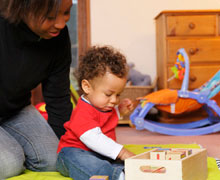Toys and Play: Birth to 12 Months
You can download this article as a PDF (English, Spanish)
 Children play from the moment they are born. Play is how they learn about themselves and their world. It is how they develop and practice the physical, thinking and social skills needed in life. These tips will help you choose toys and play activities for your child based on their age or stage of development. Think about sharing them with your child’s other caregivers, too.
Children play from the moment they are born. Play is how they learn about themselves and their world. It is how they develop and practice the physical, thinking and social skills needed in life. These tips will help you choose toys and play activities for your child based on their age or stage of development. Think about sharing them with your child’s other caregivers, too.
How Babies Play
Babies 0 to 6 months
- Follow objects with their eyes
- Enjoy looking, listening, sucking and touching
- Explore with their hands, feet and mouth
- Like bright primary colors and simple designs
- Listen to voices and may begin to imitate sounds
Babies 6 to 9 months
- Can grasp with thumb and finger
- Transfer objects from one hand to the other
- Begin to roll over both ways and sit alone for short periods
- May enjoy bath play, kicking and splashing
- Poke, twist, shake, kick, squeeze, drop, bite, pull and taste objects
Babies 9 to 12 months
- Begin to creep and crawl, pull to a stand, hold on to furniture while walking and walk alone
- Explore toys longer and like to bang, twist, squeeze, shake, drop and throw
- Show interest in moving objects
- Enjoy simple games like peek-a-boo and bye-bye
- Remember people, objects and toy actions
- Like many objects to explore
- Like to stack, put in and take out, pour out, open and close and turn things
- Enjoy pressing levers and fitting 1 object into another
- Like to empty cupboards, drawers and containers
- May enjoy pushing balls and cars
Toys and Activities
From about 2 months
- Simple rattles and teething toys
- Small stuffed animals with no plastic parts or buttons
- Soft squeeze toys
- Stuffed animals that play music
From about 4 months
- Plastic disks and keys on a ring
- Plastic rings that connect
- Soft blocks and balls
- Toys on suction cups
- Crib gyms (remove when baby can pull up on their hands and knees)
- Rattles with moving parts
- Simple floating toys
From about 9 months
- Floor activity centers
- Push toys such as simple cars or animals on wheels
- Squeeze and squeak toys
- Pull toys on short string (less than 7 inches)
- Small wooden blocks or blocks made of rubber or dense foam
- Roly-poly toys
- Activity boxes and cubes
- Pop-up boxes that are easy to use
- Non-breakable mirror toys that can be held
- May enjoy puppets held and moved by adults
- Soft baby dolls with no loose parts
- Fabric books
Safety
Choose toys that meet these safety guidelines for this age:
- Non-toxic materials
- No sharp points or edges
- Safe for mouthing
- Non-breakable
- No small parts that can get stuck in throat, ears or nose
- No parts that could trap or pinch fingers, toes or hands
- No electrical parts
- No glass or brittle plastic
- Don’t allow children to play with toys that have miniature disc or “button” batteries that can be removed easily
- Balls and toys should be large enough that they can’t be swallowed when squashed down
Learn more about toy safety and get tips for choosing toys and play activities for children of other ages.
